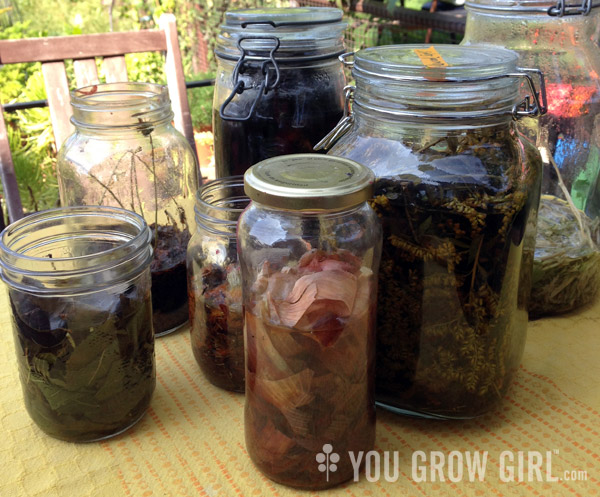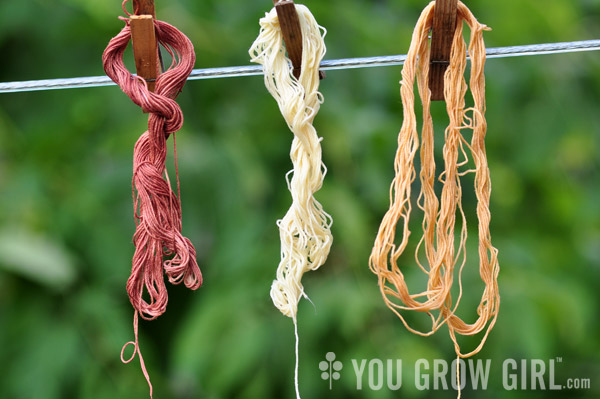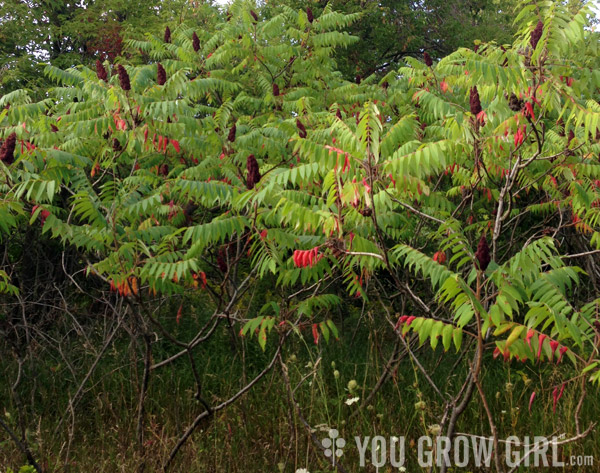
When I last wrote here about dyeing with plants it was June and I had been experimenting with fresh coreopsis flowers. Despite reports that cotton fibres CAN NOT be dyed with coreopsis flowers, I was able to use the gleanings from my garden successfully without using mordants (a fixative that allows the dye to bind with the fabric or thread more readily).
“…when dyeing with plant materials you never quite know what you will get.”

Cotton thread dyed with (from left to right): Sumac berries, lovage leaves, coreopsis flowers.
Dyeing with coreopsis was a big hit, and since clipping the flowers encouraged my plants to keep producing new buds all summer long, I went on to dye many more cotton items. The lesson I learned here is that when dyeing with plant materials you never quite know what you will get. It’s worth experimenting with different techniques and dye materials because what doesn’t work for one person may just work for you. And vice versa. I’ve also noticed that plant materials used when very fresh turn out different colours than those that are dried, fermented, or even rotted. For example, as the season progressed, I collected deadheaded coreopsis flowers (including the petals and developing seedpod) into a jar. As they collected in the jar, the top flowers dried out and some of the lower flowers got a bit… how should I put this… sludgy. As you can imagine, adding hot water brewed up liquid that was blackened with a hint of orange. When I placed thread into the jar it dyed much darker than the items that were dyed using fresh petals. I actually prefer this new result!

Sumac Berry Dye
Coreopsis is the reigning favourite dye that I can grow right in my garden. A new favourite that I foraged from beyond my garden is sumac. Staghorn sumac (Rhus hirta) is a very fast-growing shrub that grows readily in waste spaces, along roadsides, and just about everywhere really, throughout Eastern North America. Most parts of this sumac can be used as a dye or mordant. I collected stems, leaves, and dark red berries from a waste space out in the countryside and brought the parts home to experiment. So far I have only used the fruit. Some of you may know the fuzzy, red fruit as an edible that can be brewed in cold water to make a tangy, pink drink that is used as a substitute for lemonade. Unfortunately, I went out late in the season and the berries were too old for this purpose. To make a dye, I put the whole heads in a big pot of hot water and set it out in a sunny part of my garden to brew. I really need to get an outdoor burner for brewing dye. Simmering on the stove would have been faster and preferable. However sumac is botanically related to poison ivy, and while I seem to be fine with it in small quantities, I was hesitant to cook up a large pot indoors. After some time I threw in a couple of skeins of cotton thread and kept the whole thing outdoors for a few days. The result is dramatic (see photo, above). That lovely brick red colour was achieved without the use of any additional mordants. I still have loads more berries to brew and plan to use those to dye a few pieces of cotton fabric.
In addition to coreopsis and sumac I have also been experimenting with a range of plant materials that are seasonally abundant: apple leaves, apple branches, acorns, lovage (the result is meh), ‘Egyptian Walking’ onion skins, goldenrod (for that fabulous soft 70s yellow), marigold flowers (light orange), cosmos, fennel flowers and fronds, mint (nothing great yet), and black walnuts.
My long range plan is to dye fabrics using a wide range of natural dyes and eventually sew them together into a patchwork quilt.
I am a relatively new Ontario resident and I’ve been wondering for a few years what those roadside shrubs are called! I love their colour in the autumn. Thank you for putting a name to this plant for me.
Also, a homemade hand-dyed quilt would be a wonderful project.
This is wonderful! Love the natural/subdued colours of plant dyes. The folks at folk fibers do an amazing job with natural plant dyes and fabrics. Looking forward to seeing your creations. I’m pretty sure they’ll be spectacular. Best wishes! :)
I think you have poison sumac (Toxicodendron vernix: white/gray berries, not used for dyeing or eating) confused with staghorn sumac.